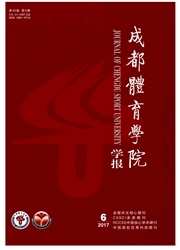

 中文摘要:
中文摘要:
目的:观察一周的跑台运动对脑缺血再灌注大鼠空间学习和记忆能力的影响。方法:采用Morris水迷宫检测大鼠定位航行和空间探索能力。结果:定位航行试验中,运动组大鼠在第二、第三次训练时的潜伏期均显著短于第一次训练(P〈0.01),而对照组大鼠仅在第三次训练时的潜伏期明显短于第一次训练(P〈0.01);组间比较,第二次训练时,运动组大鼠的潜伏期明显短于对照组(P〈0.05)。空间探索试验中,两组大鼠在站台象限游泳距离占总游泳距离的百分比多于另外三个象限;运动组大鼠在Ⅲ象限穿越站台位置次数高于对照组,但无统计学意义;运动组大鼠在站台周围游泳路程占总路程的百分比明显多于对照组(P〈0.05)。结论:一周的小强度跑台运动可改善脑缺血再灌注大鼠的空间学习和记忆能力。
 英文摘要:
英文摘要:
Objective. To observe the effect of treadmill exercise on the spatial learning ability and memory of cerebral ischemia rats. Methods: Morris water maze is used to check the position navigation and spatial exploration in rats. Results: In the position navigation test, with the increase in the training session, the dormant period in both groups decreases. The dormant period of the exercising group in the second and third training session is remarkably shorter than that in the first session ( P 〈 0.01 ) , while the dormant period of the control group in the third training session is remarkably shorter than that in the fist session( P 〈 0.01 ). Significant difference in the dormant period is found in the second session between the exercise group and the control group ( P 〈 0.05). In the spatial exploration test, the ratio of swimming distance in platform quadrant to total swimming distance is higher than that of other quadrants in both groups. The frequency of crossing platform in the exercising group is higher than that in the control group, but no significant difference is found. The swimming distance around the platform in the exercising group is markedly greater than that in the control group( P 〈 0.05 ). Conclusion: One week treadmill exercise of low intensity can improve the spatial learning ability and memory of cerebral ischemia rats.
 同期刊论文项目
同期刊论文项目
 同项目期刊论文
同项目期刊论文
 期刊信息
期刊信息
